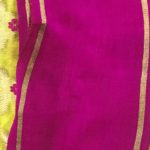She called it a boti. In Tamilnadu, the name is longer. We call it aruvamanai. It is a magical instrument that skinned vegetables, peeled them and chopped them into pieces. In Tamilnadu, it includes a coconut shredder.
She sat on the ground and made me breakfast. It was the same breakfast that I had everywhere in Bengal: puffy fried puris made with maida (called luchi here) and potatoes or aloo.
Alongside was brinjal/eggplant/baingan. Sliced and toasted in mustard oil. I had it at 8 a.m. at the home of weaver, Sanjoy Pramanik. They made me sit on the floor and placed a heaping plate of food in front of me. It was delicious.
Sanjoy Pramanik works for Bailou. He sources the sarees, makes natural dyes and works in close contact with Bappa-da as he calls Bappaditya Biswas, the co-founder of the brand. He is also, like many Indians, naturally hospitable and kind– certainly towards visiting interested textile lovers like me.
When Ray and Charles Eames wrote the Eames Report for Jawaharlal Nehru, they said that the humble lota was their design object of choice and admiration. This boti could serve just as well.
The saree too is an inventive design object. Check out the below list and see if it sparks other ideas of how you can use a saree.
Here are ten uniquely Indian design objects
The lota (a spherical water vessel). Of course. Thanks to American designer Charles Eames’ comment in The India Report, which led to the formation of the National Institute of Design in Ahmedabad, Gujarat, in 1961. “Of all the objects we have seen and admired during our visit to India, the lota, that simple vessel of everyday use, stands out as perhaps the greatest, the most beautiful,” said Eames.
The thali (plate). Perfectly suited to the multiple courses that are served simultaneously in an Indian kitchen.
The rimmed stainless steel tumbler. Used communally to drink fluids without having the utensil touch the lips. Our elders would say that it is more hygienic and uses fewer resources in terms of washing.
The tiffin carrier. A thing of beauty really, used to carry multiple courses in train compartments and for long journeys. Immortalized by Subodh Gupta in his sculptures. Still used in urban India, where caterers carry food in giant tiffin boxes in autorickshaws. Which leads us to the….
Autorickshaw. Inspired by the Italian Piaggio Ape, not as indigenous as the bullock cart, but a ubiquitous object of love and hate nevertheless.
Ambassador car. Not exactly indigenous, but has become an Indian icon. Immortalized by Jitish Kallat in his work.
Kulhad (earthen) cups .Disposable, biodegradable, hygienic. As easy on the eye as the paper plates designed by Japanese design firm Wasara (www.wasara.jp/index_e.html)
Saris. Even though pretty much every Indian apparel is an example of good indigenous design, a few stand out. The sari is intrinsic to India, and conveys the soul of our textile traditions. This unstitched cloth reflects an aesthetic that is rooted in simplicity as the essence of purity. The regional variations possible out of this fabric are mind-boggling in their creativity.
Kurta. Called tunic globally, these long tops that we wear all over India are now sold in Stockholm, Sweden, and San Francisco, US.
Bindis. Madonna wears them. Bharti Kher popularized them in her sculptures, although she doesn’t wear them herself.
Lungi. Checked or plain, the lungi, dhoti, veshti and panchakacham, are all variations of a simple cotton cloth that is put to good use by our men. In Kerala, lungis raised to half-mast to reveal hirsute legs is a common sight. Toddy tappers tie them even higher as they clamber up trees and bring down the fluid that lubricates Kerala’s love of fish.
Kolhapuri chappals. Uniquely Indian.
Mojris and Chikan work. Prada is doing a take on these.
Coir. Beds and mats are most common, but the range of objects that the “kalpavriksha” coconut tree offers range in number and drive some of Kerala’s economy.
Chattais. Woven mats. We sit on them. We sleep on them. Now we put zariborders on them and colour them pink and purple.
Jadhu (broomstick). Local materials tied together to make a cleaning object that is user-friendly, biodegradable and does its job.
Tambu. Tent. It’s used all over the country.
Turban. It finds multiple uses in the desert, from keeping your head cool to carrying some food in its folds.
Jhola. These bags have become cool these days, with modern designers putting their own spin on them.
Safety pin. Not necessarily Indian but becomes an Indian woman’s Swiss army knife and is strung in her mangalsutra. Kiran Uttam Ghosh makes tassels out of safety pins in her clothes.
Cradles made of saris in trains. Okay, so these aren’t exactly objects but examples of Indian jugaad (resourcefulness). But they conform to design firm Ideo’s credo of “human-centric design”.
Kaajal-daani. Lovely object from Madhya Pradesh, used to apply kaajal(kohl) in eyes. Comes with a mirror inside. I own one. I bought it for Rs 350 at Dastkar in Bangalore from a craftsman.
And finally, the object that we started with…..
Sit-cutting. Called boti in Bengali, addeli in Konkani, kathipeeta in Telugu, aruvamanai in Tamil, pankhi in Oriya, vili or morli in Marathi, thuriyo manein Kannada, daat in Punjabi, hansua in Bihar and Jharkhand, and kaanthnein Mangalore, this unique cutting instrument implies leisure and camaraderie in the kitchen. A beloved kitchen tool.





